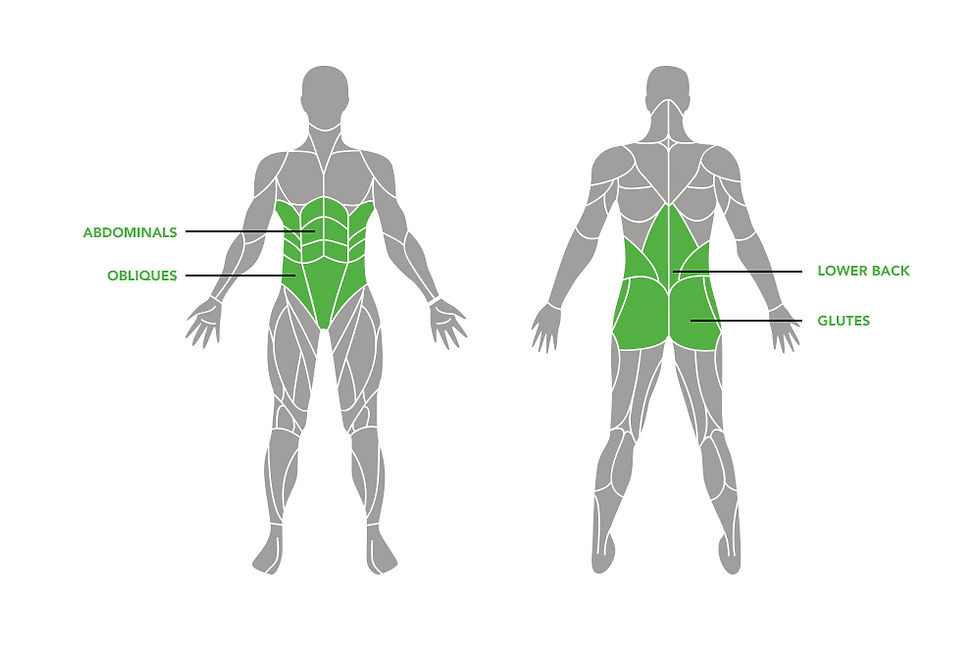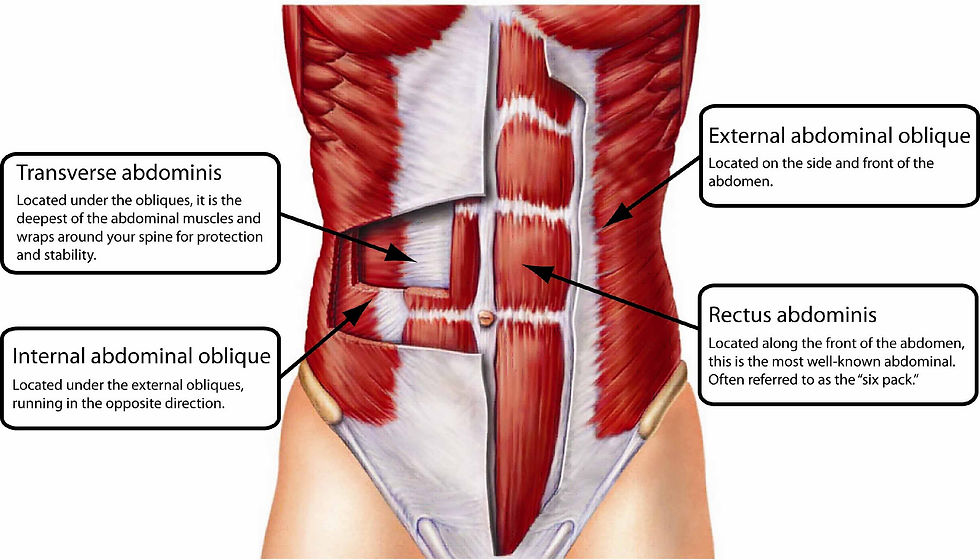CORE WORKOUT or ABS WORKOUT?
- Angela Merlino
- Sep 4, 2021
- 3 min read

When a client tells me that they want to develop their core, I always ask: what is core for you? Almost everyone replies with ‘abs’.
In this post I want to dispel some myths about the core, and talk about what is really needed to develop your core.
What is the CORE?

Firstly, your core is not synonymous with your abs; your abdominal muscles are only one of many muscles that make up the system that we call the core.

The core refers to any muscle that supports the lower lumber spine in order to hold it well.
The muscles involved in providing this support include gluteal muscles (bottom muscles), abdominal muscles (abs), Internal muscles such as: Psoas major, Illiac, Erectus spinae, Multifidus, Pelvic floor and Diaphragm. These are the key muscle groups involved.

Note that the glutes often referred to as ‘hips' in pilates, because the hips support the all of the spine.
So, I hope you are starting to see that crunches are really not going to be that effective! Crunches only work the superficial muscles of the core (picture below).

I like to think of the body like an onion. As you keep peeling the layers you get to the core and your body is similar. To make your core strong you need to work deeply into the internal muscles of the core system.
TYPES OF WORKOUT:
* EXERCISING YOUR ABS IS A WORK-OUT !
* EXERCISING YOUR CORE IS A WORK-IN !

So where do you start if you want to
develop your CORE?
It may surprise you to know that making sure that your breathing is correct is a fundamental aspect of developing your core.

Have you ever noticed that perhaps it is easier for you to inhale or exhale?
Have you ever asked why you hold your breath?
Have you wondered why your breathing is shallow at times?
The answers to these questions are inside your core.
To understand this we look to somatic therapy, which helps us to understand the body-mind connection.

The simple answer is that the patterns we learnt from our childhood, education and life experience influenced our breathing. And we hold these patterns in our core.
From the Transpersonal point of view, we would say:
* The inhale has to do with receiving the blood into the heart.
* Exhale has to do with giving to the system / body.

If you find it easier to exhale, it refers to your abilities of self expression, communication skills and speaking your truth.
These functions relate to the left side of the brain, and involve action taking.

The right side of the brain is connected to the inhale. It relates to emotional connection, intuition, creativity, feminine skills and receiving.

How are the breath and core connected?
Our breath is controlled and connected to the diaphragm, the main instrument for breathing. It is an involuntary muscle and is one of the deeper muscles of the core.

For your core to engage, your diaphragm must function smoothly to maintain its connection to the core.
Many clients tell me that they cannot feel their core.
Can you feel your core?
Usually the reason for this is comes down to breathing patterns. When you are breathing organically, your core muscles engage automatically. Another benefit of being mindful of your breath whilst working out is that it prevents the buildup of lactic acid which makes the muscle fibres more susceptible to damage.
You will find yourself less sore after a workout if you stay mindful of your breathing.
This is because when breathing organically, the muscles naturally open and contract in its natural rhythm instead of being forced against it. So if you exercise mindfully, your body can build that muscle more quickly over the long term. Without the breath, long term exercise can cause muscles to become bulky and tight, resulting in flexibility.
See the difference in between Mindful
exercise and Abs workout.
Working only on your ABS (which is just a part of your CORE) can reduce your flexibility. For the core to be strong it needs to also be flexible.

The reality is that engaging the core starts with the breath and learning to breathe organically throughout the movement.

Mindful exercise doesn't involve tension but requires strength, flexibility, balance, alignment, coordination, core, body-mind connection and breathing technique.
Stay tuned!
Angela

If you would like a breath and ab work session or an integrated core session, then get in touch so that you can learn to use your breath to develop your core.
Let me help you to to overcome any resistances and blockages in your body. Angela
Email me to ask for prices and packages.


Comments